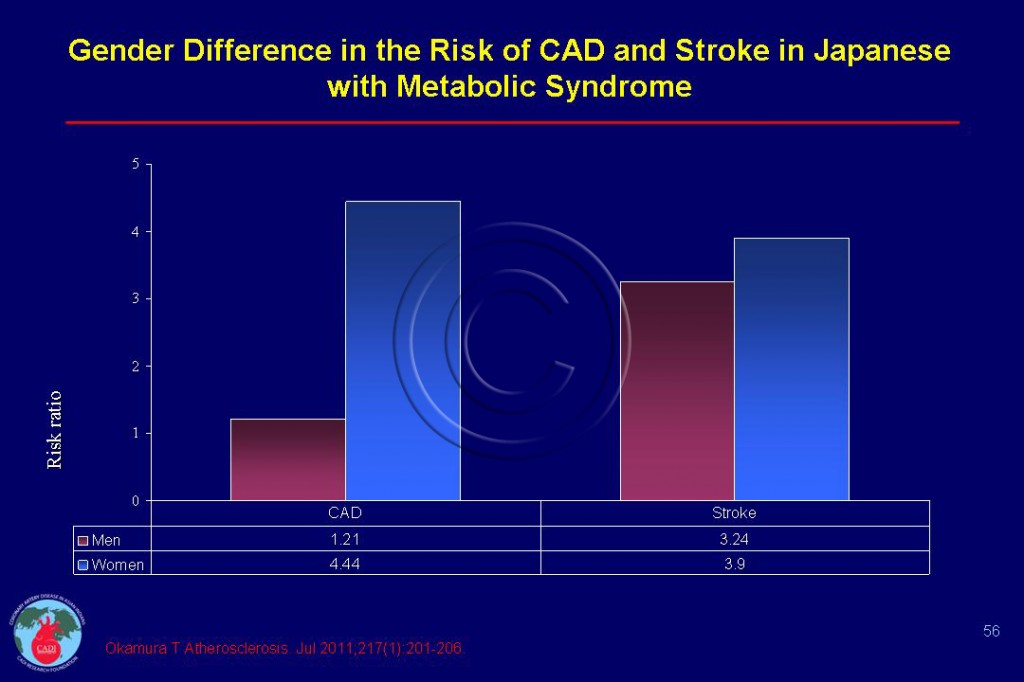Metabolic Syndrome in Women
- The metabolic syndrome (MS) is more prevalent and more strongly characterized by obesity and low grade inflammation, subclinical coronary atherosclerosis in women than men.1, 2 MS confers greater cardiovascular disease (CVD) risk in women particularly younger women and its prevalence is increasing, more rapidly in younger women.3, 4
- Many studies particularly in India have shown a 50% to 75% higher prevalence of MS among women than men.5, 6 In India, the overall prevalence of MS was 29% in men and 46% in women in a large study involving nearly 20,000 subjects from 10 different regions of the country.6, 7 Another study found a MS prevalence of 31% in women and 18% in men using NCEP criteria8. The prevalence is as high as >80% among Indian women with diabetes.9
- In sharp contrast, the prevalence of MS is similar or lower among Indian women than men in the US.6 In one US study, both men and women had a prevalence of 38% 10while in another study, women had only half the prevalence (17% women and 30% men).11
- In the United Kingdom, the age-adjusted prevalence of MS was 41% higher among South Asian men and 140% higher among South Asian women compared to whites.12 Furthermore, compared with whites, MS develops 10 years earlier among South Asian men and 20 years earlier among South Asian women.12
- Japanese women with MS had a 4-fold higher risk of stroke and CAD which was substantially higher than in men (Figure 056).13 The CAD risk is exponentially increased in women who have both diabetes and MS in the San Antonio Heart Study. Compared to women with neither diabetes nor MS, women with both had a 14-fold increased risk of CAD mortality, whereas men had only a 4-fold increased risk (adjusted for age, ethnic group, and a history of CVD).14 Other studies have shown extensive CAD in women with MS.15
- In gender specific analyses, MS increased the risk of all-cause mortality in women 2-fold, but no such increase was found in men.16
Sources
1. Tonstad S, Sandvik E, Larsen PG, Thelle D. Gender differences in the prevalence and determinants of the metabolic syndrome in screened subjects at risk for coronary heart disease. Metab Syndr Relat Disord. Jun 2007;5(2):174-182.
2. Ratti C, Grassi L, Chiurlia E, et al. [Coronary calcifications in a subgroup of post-menopausal women with metabolic syndrome]. G Ital Cardiol (Rome). Sep 2007;8(9):574-579.
3. Mente A, Yusuf S, Islam S, et al. Metabolic syndrome and risk of acute myocardial infarction a case-control study of 26,903 subjects from 52 countries. J Am Coll Cardiol. May 25 2010;55(21):2390-2398.
4. Mozumdar A, Liguori G. Persistent Increase of Prevalence of Metabolic Syndrome Among US adults: NHANES III to NHANES 1999-2006. Diabetes Care. Oct 1 2010.
5. Enas EA, Mohan V, Deepa M, Farooq S, Pazhoor S, Chennikkara H. The metabolic syndrome and dyslipidemia among Asian Indians: a population with high rates of diabetes and premature coronary artery disease. Journal of the cardiometabolic syndrome. Fall 2007;2(4):267-275.
6. Reddy KS, Prabhakaran D, Chaturvedi V, et al. Methods for establishing a surveillance system for cardiovascular diseases in Indian industrial populations. Bull World Health Organ. Jun 2006;84(6):461-469.
7. Ramachandran A, Snehalatha C, Satyavani K, Sivasankari S, Vijay V. Metabolic syndrome in urban Asian Indian adults–a population study using modified ATP III criteria. Diabetes Res Clin Pract. Jun 2003;60(3):199-204.
8. Gupta R, Deedwania PC, Gupta A, Rastogi S, Panwar RB, Kothari K. Prevalence of metabolic syndrome in an Indian urban population. Int J Cardiol. Nov 2004;97(2):257-261.
9. Raman R, Gupta A, Pal SS, et al. Prevalence of Metabolic Syndrome and its influence on microvascular complications in the Indian population with Type 2 Diabetes Mellitus. Sankara Nethralaya Diabetic Retinopathy Epidemiology And Molecular Genetic Study (SN-DREAMS, report 14). Diabetol Metab Syndr. 2010;2:67.
10. Misra R, Patel T, Kotha P, et al. Prevalence of diabetes, metabolic syndrome, and cardiovascular risk factors in US Asian Indians: results from a national study. Journal of diabetes and its complications. Mar 18 2009.
11. Flowers E, Molina C, Mathur A, et al. Prevalence of metabolic syndrome in South Asians residing in the United States. Metabolic syndrome and related disorders. Oct 2010;8(5):417-423.
12. Tillin T, Forouhi N, Johnston DG, McKeigue PM, Chaturvedi N, Godsland IF. Metabolic syndrome and coronary heart disease in South Asians, African-Caribbeans and white Europeans: a UK population-based cross-sectional study. Diabetologia. Apr 2005;48(4):649-656.
13. Okamura T, Kokubo Y, Watanabe M, et al. A revised definition of the metabolic syndrome predicts coronary artery disease and ischemic stroke after adjusting for low density lipoprotein cholesterol in a 13-year cohort study of Japanese: The Suita Study. Atherosclerosis. Mar 15 2011.
14. Hunt KJ, Williams K, Hazuda HP, Stern MP, Haffner SM. The metabolic syndrome and the impact of diabetes on coronary heart disease mortality in women and men: the San Antonio Heart Study. Ann Epidemiol. Nov 2007;17(11):870-877.
15. Kasai T, Miyauchi K, Kubota N, et al. The relationship between the metabolic syndrome defined by various criteria and the extent of coronary artery disease. Atherosclerosis. Apr 2008;197(2):944-950.
16. Kragelund C, Kober L, Faber J, Steffensen R, Hildebrandt P. Metabolic syndrome and mortality in stable coronary heart disease: relation to gender. Int J Cardiol. Sep 14 2007;121(1):62-67.


